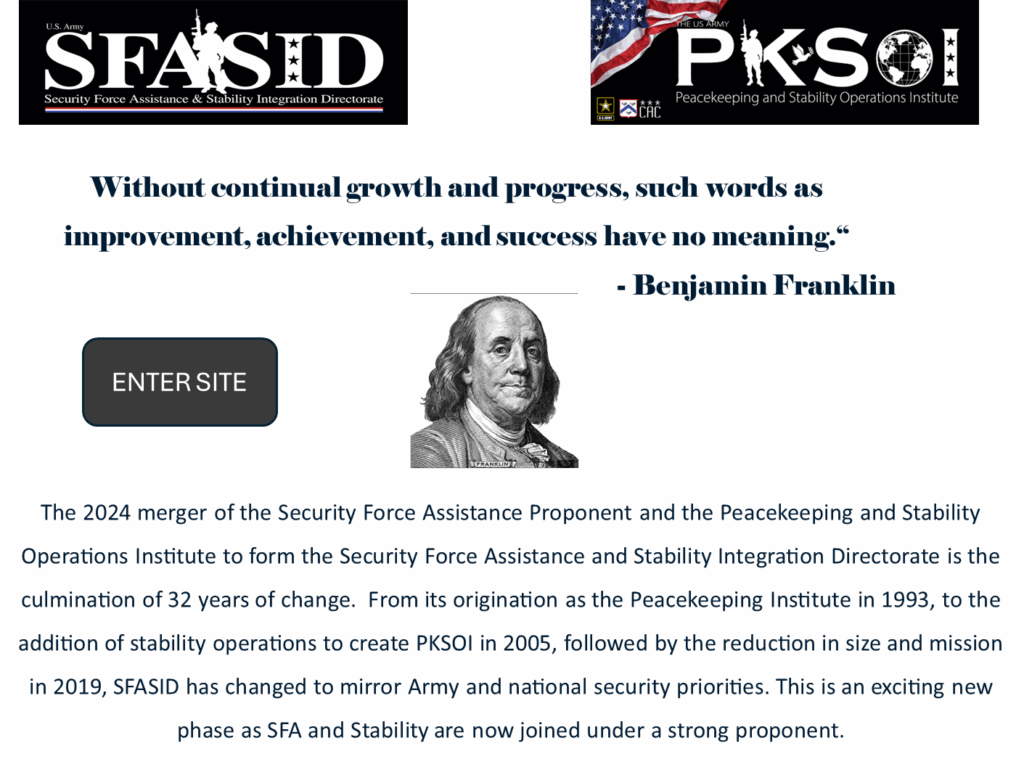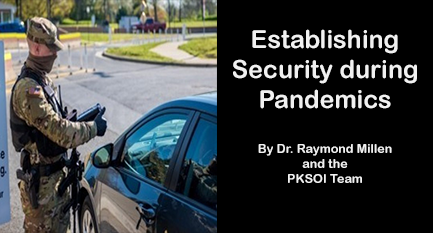Establishing Security during Pandemics
16 July 2020
By Dr. Raymond A. Millen and the PKSOI Team
Peacekeeping and Stability Operations Institute
.jpg)
Since pandemics are global by definition, the United States must choose where to intervene when national interests and strategic objectives are threatened. As the 28 April 2020 PKSOI paper, US Global Stabilization Strategy for the COVID 19 Pandemic avers, sharing the response burden with partner nations, international organizations, and NGOs is pragmatic. Burden-sharing is a time-honored tradition among great powers and makes good strategic sense.
Domestic security and rule of law are generally the greatest challenges for fragile states. The added stressor of a pandemic can trigger a collapse of both. Fragile states should receive the highest priority when considering where to intervene. If the United States must intervene in a country devastated by an epidemic, establishing security becomes imperative.
As a critical joint stability function, the ability to maintain security during an epidemic is a key indicator of a country’s resiliency. Aside from medical services, the police are the most vulnerable to epidemics because of their close association with the public. If the police services are incapacitated due to illness or death, law and order becomes paralyzed, and hence the fabric of society can quickly unravel.
Law and order is largely psychological stemming from the tacit consent of the populace to obey laws. Criminal elements are normally the first to exploit the breakdown in police authority, resulting in a spike in crime. Once disorder and panic become widespread, a state of anarchy occurs with general mayhem infecting the populace. Without basic law and order, comprehensive rule of law principles become meaningless. At this point, the police cannot regain control, and thus martial law under a military occupation is a normal recourse.
In the immediate onset of a pandemic, the reinforcement or establishment of security is a preventive measure to uphold the integrity of society. This paper addresses the essential activities to preserve security: 1) re-establishing the police; 2) securing critical facilities; 3) protecting emergency services; and 4) combatting detrimental tendencies. Hence, preserving the psychological component of law and order becomes the overriding objective.
Re-establishing the Police
As with any devastating disaster, people become paralyzed by fear and the enormity of the event. Afflicted governments normally mobilize the police and military forces in response. If they prove inadequate (or fall victim to the epidemic), an intervention with international police is the ideal choice to support the police. However, if the environment is non-permissive or access is limited, then US military forces would be the first responders. If available, expeditionary police (e.g., NATO carabinieri and gendarmerie) should accompany military forces. These police have a mandate to police civilians and are the best choice. However, in the absence of such deployable police, US military police would be the next best option.
As an organizational technique, small civil affairs (CA) and police teams (8 personnel) should accompany military tactical units into affected urban areas to establish transitional public security. Only those urban areas experiencing pronounced insecurity require a tactical sweep to establish immediate authority. Otherwise, the CA/police teams may enter alone.
Upon entering an urban area, the CA/police team immediately locates the political authorities and chief of police, or appoints new ones if needed. Since the authorities may be paralyzed by the chaos, the team’s initial task is to spur the community into restorative action. The guiding principle of the team is to govern indirectly, supervising the activities of established authorities.
The CA/police team distributes the joint commander’s proclamations and ordinances to the political authorities to disseminate to the populace (e.g., bulletin boards, all media, and town hall meetings). The proclamations inform the local populace of the reason and intent of the intervention, assuring them that existing laws, customs, and institutions shall remain unchanged. The ordinances serve to restore public order (e.g., curfews and prohibited areas). Generally, they include temporary prohibitions on movement and activities that may interfere with military operations. The establishment of martial law is a senior political decision and is used only in extreme circumstances.
The CA/police team directs the chief of police to recall all police, including retired police, for accountability and security assignments. If needed, the team authorizes the police chief to deputize responsible citizens as auxiliary police, providing the list of enrolled police for team review. Local militias, neighborhood watches, and private security for businesses are acknowledged as emergency security measures. The team may need to provide salaries for the police and auxiliary police, so the military chain of command must provide guidance or funds for this purpose. As an alternative, the team may use existing municipal funds at the bank for salaries, but due care is required to ensure financial accountability is strictly maintained.
Securing Critical Facilities
The police chief is directed to deploy the police immediately to secure: financial institutions, post offices, government facilities (e.g., city hall, courts, and revenue collection), jails/prisons, cultural centers, and key utilities. Critical facilities are the first places looted and destroyed, so they receive priority. In extreme cases, the teams may request the temporary deployment of tactical units to the urban area if situation warrants.
Financial institutions (e.g., banks, insurance, and depositories) should remain open but with increased security as a deterrent to robbery and burglary. Temporary closures may trigger a financial panic, which must be avoided at all costs. The prevention of looting signals that wanton behavior is not tolerated, thereby curbing disorder early. Clear rules of engagement are required to protect property with the minimum use of force.
The protection of post offices ensures money orders and related financial documents remain safe. The preservation of government and legal documents is to prevent their destruction by criminal elements. As a public safety, preventing the release of incarcerated criminals or political prisoners staunches future instability. Safeguarding works of art, monuments, and similar national treasures thwarts illicit trading.
While wanton damage and ransacking of public utilities is a self-inflicting wound to the community, it happens so frequently that protection is a security necessity. Disruptions to electrical grids, power stations (e.g., nuclear, hydroelectric, solar, and wind), waterworks, and waste disposal quickly affect health, so security, repair, and maintenance are required. If local utility workers cannot repair damaged utilities, the CA/police team alerts the chain of command for the deployment of technical specialists.

Protecting Emergency Services
Fire and medical services are essential to rescue and health care. The police must protect fire equipment, medical facilities, and medicines from theft and damage. Stolen medicine quickly becomes a black market commodity, so securing medical storage units is both a medical and criminal prevention necessity. The prompt implementation of emergency services reassures the populace that their safety is foremost, thereby mitigating possible upheavals due to frustration, anger, and panic.
Since epidemics result in inordinate death rates, emergency services must visit all homes to recover bodies for burial. Teams may need to request assistance and equipment for mass burials from the chain of command. In the interim, the CA/police team may hire local labor for burial details. Similarly, medical services may become overwhelmed by mass casualties, so additional military medical support would be required.
Heightened police or neighborhood patrols serve to protect vulnerable houses and businesses from burglary or ransacking. An epidemic may so devastate the population, that several houses and businesses become vacant. Immediate response to even small criminal activities is necessary to maintain public confidence in law enforcement.
Local and supplemental medical services establish quarantine measures to isolate and care for infected people. Medical services advises the CA/police team on the most vulnerable groups for isolation. Those groups most resilient to the disease may continue daily activities to generate herd immunity. Additionally, the team must remain vigilant to outbreaks of other diseases. Virulent viruses often exhaust antibodies and cause weakened autoimmune systems. In such cases, people become susceptible to pneumonia because the body cannot combat the introduction of ordinary germs.
Combatting Detrimental Tendencies
Aside from looting, hoarding results in critical shortages of commodities and fuels the black market. Farmers and other food providers may resort to hoarding in order to raise the price of commodities. Police must actively seek information on hoarding activities and storage locations. Police raids and anticorruption operations are generally an immediate remedy.
The police chief should provide the CA/police team with information on local criminal bosses or warlords. The team should establish a polite but firm dialogue with them. The idea is not to ignore them but acknowledge their presence and come to a working understanding. Gaining their cooperation for security may not be possible, but talking with them reduces potential tensions.
Although militias are often instrumental in providing immediate security, over time they can become a public threat, preying upon the populace. The CA/police team must address any acts of drunkenness, theft, or intimidation with the militia leaders. Once the crisis subsides, the team may seek an informal disarmament, demobilization, and reintegration (DDR) of the militia, but this often takes a great deal of persuasion. DDR discussions may serve to identify potential candidates for recruitment in the police and military forces. Accordingly, the police chief and host nation military commanders may enlist qualified militiamen to replace losses.
Conclusions
Epidemics generally do not infect an entire country evenly. Some areas are impacted harder and faster than others. Logically, intervention forces deploy into the high-threat areas first and attend to the other areas later. The immediate objective of establishing immediate security in an urban area is to staunch disorder before it turns into widespread mayhem. Often, the presence of police suffices to deter criminal behavior and reassure the populace. The presence of corrupt and incompetent police is likely, but the exigencies of the crisis require their continued employment. CA/police teams should identify them in situation reports for host nation government awareness and action after the crisis.
Small CA/police teams are an appropriate instrument to prompt restorative action during an epidemic. Once security is restored in one community, a CA/police team may expand its area of responsibility by conducting maintenance visits to other nearby communities. This method frees up other CA/police teams for deployment to other communities showing signs of the epidemic.
Transitioning responsibility to international police, civilian organizations, or the host nation should occur from the lowest levels and then progress upwards. This approach enhances local capacities and ensures central government capacity is not overwhelmed by the enormity of the disaster. In line with global interests and strategy, the United States should optimize the use of stabilization partners for most affected countries. When US military intervention is necessary, the approach as outlined in this paper provides the requisite security for the prompt recovery of the afflicted country.

